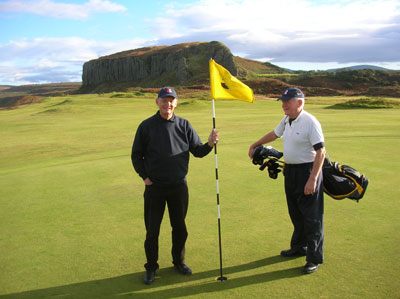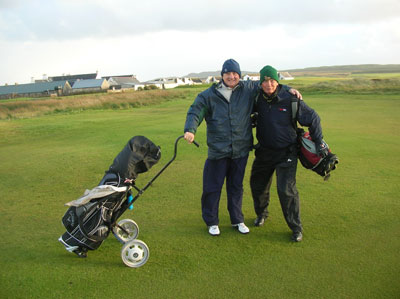Taking some time out for tee in Scotland
This item appears on page 44 of the January 2015 issue.
When it comes to golf destinations, Scotland tops the list. All visits to this unspoiled land — rich in history, culture, cuisine and, of course, whisky — require careful planning to make the most of the journey. However, a golf-tour itinerary, in particular, requires a more structured approach.
Nongolfers, don’t turn the page yet! Every golf trip I have made to Scotland has included destinations that would have appealed equally to my wife, a nongolfer.
There are countless reasons to visit: castles; history; discovering one’s heritage; hiking; salmon fishing; special events, like the Edinburgh Tattoo; rugby, soccer and Highland games; the heather, and, most of all, the scenery.
Planning a trip
Scotland is a world in one country, despite its ranking only 41st in size in comparison with each of the US states. (It is smaller than South Carolina.) It measures only 440 kilometers from north to south and just 250 kilometers at its widest point, so, even taking the narrow, winding roads into account, it’s an easily negotiated landmass.
Within its borders lie more than 500 golf courses, so the first matter to consider when planning a trip is where to play, because there are some very different opportunities.
The majority of the traditional big-name courses are divided between the west coast, near Glasgow, and the east coast, which is where you will find the most sought-after destination for global golfers: St Andrews, the “home of golf.”
St Andrews has to be on your “bucket list” not just because of the variety of its golf courses but also because of its traditions and history.
For golfers, there is the factory that manufactures classic clubs, the museum, the interaction with caddies (if you can afford them) and the sheer experience of playing such famous courses.
For nongolfers, there is the scenery; walks along the beaches (where the beach scenes in the movie “Chariots of Fire” were filmed); window-shopping in the picturesque town; the history; the university (which Prince William attended); the delightful pubs; the friendly people, and the warm B&Bs and extremely comfortable, if old, hotels.
The golf courses managed by the St Andrews Links Trust — the seven courses that can be considered “St Andrews” — are public spaces. I’d recommend a walk there in the evening.
An introductory visit
My first visit to Scotland, 10 years ago, was in fact not to St Andrews but focused on the courses with which my club in South Africa, Royal Cape, had reciprocity, a great golfing tradition. Many clubs around the world have this relationship, whereby members may play the reciprocal club’s course, usually free of charge.
This route took us up the center of Scotland, then along the northeastern coast from Inverness to Aberdeen. It was then that we discovered the warmth of the people and the excellence of the cuisine in some of the country’s remote restaurants and pubs.
Most of the golf courses played on that trip and subsequent trips were true “links” courses, courses built on sandy land between the sea and the farmlands, usually bordered by heavy grass (making shot accuracy vital). These courses make for stunning scenery and often are accompanied by walking trails along the shore for nongolfers to enjoy.
What that visit also introduced to me and my two golfing friends from Cape Town, where I live, was the opportunity to play lesser-known courses outside little country villages and towns, usually at very low cost (as little as £20, or $31, and less), often with a cozy pub and characterful accommodation nearby and always with a big welcome.
Off-track travel
Exploring the byways of Scotland, if you are an adventurous traveler, makes for a special experience. The roads are good, if narrow at times, distances are short, and accommodation is prolific, usually offering excellent value.
If there is a criticism, it is that many hotels are a little shabby, but this is compensated for with friendly service and reasonable pricing. Allow for a daily average of £30 ($47) for meals, including wine and whisky, and £60 and more for bed-and-breakfast accommodation. You can choose far more expensive (and, therefore, more luxurious) accommodation, but it may not always provide the same level of personal attention.
My more recent visits, in mid-2010 and autumn 2012, have been to the west coast, specifically the Inner Hebrides, including the island of Islay, home to just one golf course but also to several renowned whisky distilleries, where the whisky is particularly peaty in flavor.
Reaching these destinations involves several ferry rides — adventures in themselves but very slickly operated. For booking and route information, take a look at www.calmac.co.uk.
Not only are the courses on the west coast really special (in particular, Shiskine on Arran; Machrihanish and Dunaverty at the foot of the Kintyre peninsula, and Machrie on Islay, the latter with many blind-tee and -approach shots), but the scenery and the hiking opportunities are stunning.
And for whisky drinkers, don’t miss the guided tours of the distilleries on Islay. There are several distilleries, but clustered close together are Laphroaig, Lagavulin and Ardbeg. (Ardbeg offers a restaurant as well.)
Recommended reading
Interested? My firm advice would be to order a copy of Allan McAllister Ferguson’s comprehensive travel-planning guide “Golf in Scotland” (www.fergusongolf.com). The latest edition, the fourth (available on Amazon.com for less than $20), features 74 golf courses and 13 itineraries, six under $2,000.
Allan lives in Denver, Colorado, and keeps his travel guide up to date, creating memorable trips to Scotland for golfers and visiting there at least twice a year.
To say that the guide is a “good read” would be an understatement. It is not just an excellent travel guide, providing useful reference and contact information, travel tips and golf course recommendations, it is also a darned good “armchair” read. And having read the guide is particularly useful when any one of the many classic Scottish courses creeps into “golf talk.”
Allan lists itineraries by region, by type of golfing experience (sea views, parkland) and by designer. But to plan your own itinerary, I’d suggest getting a map of Scotland to plot your destinations. If you are going there specifically for golf, you can travel around a region to visit different courses or base yourself in one hotel and play all the courses in the region over a period of days (such as those in East Lothian, St Andrews and Carnoustie).
I have found myself not just reading Ferguson’s book but using it… for route-distance planning, contact details, accommodation and restaurant selection and all the other small details that one needs when planning a self-drive holiday.
Each of his course recommendations is accompanied by at least a page of “non-golf notes and lodging,” including suggestions on where to eat, all based on years of research and personal experience, making it of real value to nongolfers as well.
Recommended courses have green fees ranging from the very lowest, at £20 (the 12-hole Shiskine), to the very highest, around £200 (Kingsbarns near St Andrews and Muirfield in East Lothian). Each description contains detailed contact information, historical data and prices related to tee times and multiple rounds.
Final considerations
The book’s course selection is supported with further chapters on useful travel information: best times to visit Scotland; money-saving opportunities; recommended itineraries, and various checklists, including Internet sites and tourist information offices.
Best of all is the comprehensive guide to golf at St Andrews and how to get a tee time on the Old Course, reputedly a most difficult achievement. There are now eight ways listed, one up on his previous book’s recommendations, the last added being “Check the St Andrews Links website (www.standrews.com) for a cancelled booking.”
If I sound like a salesman for Allan’s book, let me emphasize that I am just an enthusiastic and adventurous traveler.
When planning a time to visit, important considerations include the facts that July and August are very busy, the west coast is wetter but warmer than the east coast, and Scotland is one of the northernmost countries, so summer days are long (you can play golf until 10 p.m.) and winter days are very short (in January, the sun rises around 9:00 and sets around 4:00). My experience is that late March/April and September are good times to visit.
But how much should you expect to spend? On our last visit, three of us enjoyed, over seven days, very average accommodation; excellent food, wine and whisky; a car hire (if you are playing golf, you’ll need to choose a hire car wisely to allow space for golf clubs); ferry fees, and golf every day for a total of about £200 per person per day. Better accommodations would obviously increase that figure.
If you would like further comments, you are invited to email me (aramsay@iafrica.com) at my home in Cape Town.



